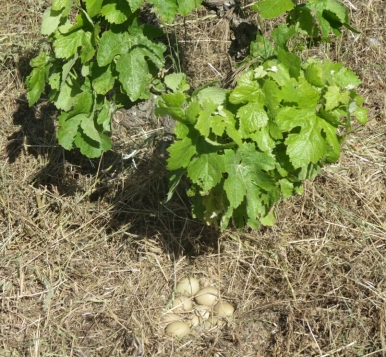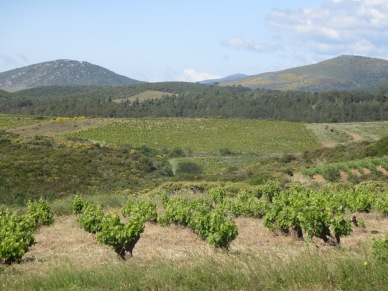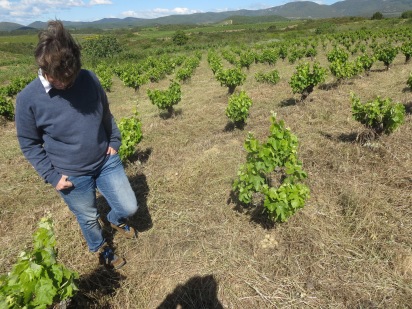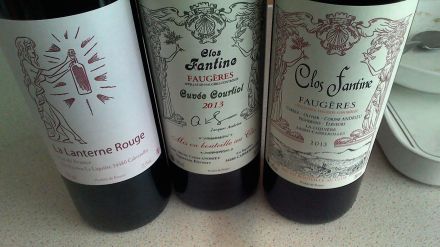I have visited hundreds of vineyards over the years but very few have stirred the same excitement and admiration as those of Clos Fantine, run by the Andrieu family of Corine, Carole and Olivier. With a helping hand from their New York importer Camille Rivière, who also imports Mas Coutelou wines, Corine asked me to visit on May 21st and I returned on June 11th.
There are around 30ha of vines around their base in La Liquière high in the Faugères hills. The soil is schist, Corine told me of 3 types, grey, blue and pink. This slaty soil makes it difficult for vines to send their roots down into the bedrock as it ends to lie horizontally, so they must seek fissures and faults for their roots to penetrate as the topsoil is meagre. This undoubtedly adds to the qualities of freshness and energy which mark so many of the best Faugères wines and certainly those of Clos Fantine. Corine explained that they do not try to fight this natural acidity but rather they work with nature, a philosophy which is fundamental to every aspect of the domaine. Nature rules, the Andrieus guide it perhaps.
The three siblings took over the running of Clos Fantine from their father in 1997 and continued to work conventionally until 2000 when they began to use the natural yeasts of their terroir and then, in 2004, more confident of their vineyards and of themselves and of their ideas and beliefs, they stopped adding sulphites. This was no trendy whim on their part, they were certainly not riding a natural wine bandwagon. Corine is a qualified oenologue who reads widely around viticulture and agronomy. She used, and still uses, her scientific background to guide her winemaking as well as the philosophy about nature which she shares with her family. As she said to me, “You have 3 core tenets; the use of science, faith in what you are doing and the art in creating the wine.”
As we drove around the vineyards with their stunning setting there was a true feeling of well being. We met Olivier who was hard at work in one parcel strimming grass between the vines. The Andrieus do not plough the soil as they feel that this upsets the balance of it, and that the hot Languedoc sunshine and strong winds would dry the soil out too much if ploughed, leading to erosion of the already thin topsoils. Sunshine is not a problem in the region, water is and by not ploughing the family also help to preserve the water in the soil. Grass, flowers and other plants grow naturally and when the grass is fully grown and starts to seed they strim it to add organic matter to the soils and seed for the following year.
The grass also provides shelter for insects and spiders which in turn will help the vines by attacking grape parasites such as ver de la grappe. These are real living vineyards, illustrated by the discovery of two separate partridge nests, both filled with eggs, at the base of vines in that one parcel.
Corine talked about how they see the land as between 3 stages, farm/grassland, garrigue and forest. They are seeking to keep their vines on the edge between the first two stages so that the vines are having to work a little to compete with flora and fauna without being overstressed. Meanwhile, Olivier also spoke about keeping good quality air around the vines, eg allowing the air to circulate freely around the vines to keep disease at bay and also about using the flowers and grass.
Disease, of course, is an issue at the domaine despite their hard work to minimise it. This is true of all vineyards. Mildew had hit when I was there in May, nothing too serious but a reminder that nature can also be cruel. Natural treatments available to them include the use of sulphur and copper which had been used for the first time in a few years. However, the vines were not in any danger, the mildew had been contained.
All the vines are gobelet, low to the ground. Corine described how they had recently bought a parcel of vines and their first action was to remove the palissage, the stakes and wires used to train the vines. The vines flopped and spread out as if relaxing, in Corine’s words, like a woman released from her corsets in Victorian times. Gobelet is the traditional method of growing vines in the Languedoc. The bushy vines have plenty of foliage to shelter the grapes from the sun but also have space to fan out allowing the air inside to stop humidity and defend against disease. The gobelets did give the impression of a vineyard which could have been from any period of the last few centuries, ageless.
Corine used the word ‘energy’ a lot whilst I was there. She was referring to the soils and the vineyards. The nurturing of the soil and the vines is about channelling the energy of nature into those vines and ultimately the grapes and the wines through their management of soil and air. However, energy also describes the work of Corine, Olivier and Carole. They are relentless in their quest to improve the vineyards and the wines.
They read widely, for example Corine is an admirer of Jean Marie Pelt and his writings on plants and nature. She quotes science, history and nature readily and compares her wines to others in the region but also to wines and vineyard practices from the rest of France and internationally. Corine seeks to learn from these and we talked about viticulture in Australia and Chile, as there are little things done there which might help to improve wines, “we may never be perfect but we can try to be the best we can be.” This awareness of learning and the outside world is more widespread than it used to be in France but I have not come across that many vignerons who are so keen to learn from various sources.
At the start of this blog article I mentioned how happy and at ease I felt in the vineyards of Clos Fantine. The location, its touch of wildness and nature together with the philosophy of the Andrieus all rubbed off on me too.
At that point a wagon arrived to collect some palletts of wine to take to Belgium. As the domaine is up a narrow road Corine was going to have to transport the wines using the forklift down to the wagon in the village. I was actually quite pleased as it gave me the opportunity to return a few weeks later to visit the cellars and to taste the wines.
As a storm broke over La Liquière on June 11th it was a dramatic backdrop in which to return. The cellar has been designed to allow the grapes to be moved by gravity rather than pumping after being harvested by hand and gathered in small cagettes. The cement vats we tasted from were full of single variety wines busy fermenting. Corine uses no pigeage or remontage in the vats, something which was new to me, and as the weather cools down in autumn and winter the cellar doors are opened to allow the temperatures to drop and halt the fermentations naturally. These resume in spring as temperatures rise again. The result is a gentle, long and cool maceration with as little intervention as possible.
And the results… Well we tasted Carignan, Syrah, Grenache, Mourvèdre from the vats and each was clear, direct, mineral and oh so fresh with fruit singing out. They were also classic in their cépage typicity, it was relatively straightforward even for me to identify each one. They were excellent as was a Terret from a barrel which contained wines from a number of vintages, in other words in a solera type system. Complex, long, mineral and the slight oxidative notes were refreshing and interesting.
We then retired to the kitchen and tasted from bottle. The Terret, Valcabrières, was a delight. Great depth of flavour with zesty refreshment and white fruits such as notes of pear. Long in the mouth it was delicious. Recently bottled it was already very good but will improve as it settles in bottle. Lanterne Rouge is Aramon and Cinsault, very much Languedoc varieties and a wine I have described on here a few times as it is a favourite with lively fruit aromas and a deceptively light first taste which grows more complex in the mouth. The Clos Fantine Tradition is mainly Carignan and Grenache and has real depth of dark fruit flavours and great complexity and a refreshing, clean finish. It is classic Languedoc red wine but with added zest and liveliness. Finally Cuvée Courtiol is made from the best grapes of the millésime. Ripe, full and delicious with length and soft tannins that will marry into the wine with age. I really love these wines and when Corine said there was no obligation for me to buy any wines when I asked if I could, I hastened to reassure her that I felt no obligation, I wanted to buy some and will certainly want to do so again!
I learned so much in my time at Clos Fantine with the Andrieu family and I admire and respect their work, their philosophy, their passion for learning and nature and, of course, their wines. I implore you to seek out their wines and drink them.












June 19, 2015 at 1:48 pm
This sounds like a wonderful producer, with great vineyard practices and fascinating wines. I wish I knew about them when we spent a week in that area several years ago. Hopefully we’ll return. I have never seen the wines in the US; maybe I’ll look next time I’m in New York.
LikeLike
June 19, 2015 at 2:58 pm
Definitely should return Bob. These are very good wines from producers who really care about their vineyards and think carefully about how they work.
LikeLike
August 26, 2015 at 3:59 pm
Bob, you can get them from plenty of retailers in NY, and depending on your state they will ship too. winesearcher.com
LikeLike
August 27, 2015 at 1:38 pm
Thanks Camille. Next time I’m in NY I’ll look for it (at Chambers Wines or a shop in Brooklyn), as well as other wines of yours, such as Mas Coutalou.
LikeLike
June 22, 2015 at 1:01 am
I feel I must add a visit to Clos Fantine to my busy schedule, Alan! 😉
LikeLike
August 25, 2015 at 2:36 pm
Thanks for sharing this visit in words and pictures, I look forward to visiting Clos Fantine myself someday. Interesting how the landscape.looks so green given the minimal topsoil and hard schist bedrock. Having visited the Douro Valley which is also predominantly schist rock soils/bedrock I had visions of more brown and straight rock vineyards.
LikeLike
August 25, 2015 at 4:57 pm
You’re welcome Tom. No we are in the hills of Languedoc around Faugeres, in the foothills of the Cevennes. Very green, very open. They are lovely people and the wines reflect themselves and their land. If you do get round to visiting in the next few months give me a shout 🙂
LikeLike
Pingback: Living wine history | amarchinthevines
Pingback: Case of 2015 – reds | amarchinthevines
Pingback: Twenty 15 highlights | amarchinthevines
January 20, 2016 at 8:00 pm
Great and detailed blog – I love Clos Fantine and this 2013 is spot on although I have a disappointing batch of 2011 which has effervescence
LikeLike
January 21, 2016 at 9:25 am
When you say batch? “Disappointing” is generous in the circumstances.
LikeLike
Pingback: Real? RAW? Just very good | amarchinthevines
Pingback: Loving Languedoc | amarchinthevines
Pingback: Real Wine Fair #3 – the beat goes on | amarchinthevines